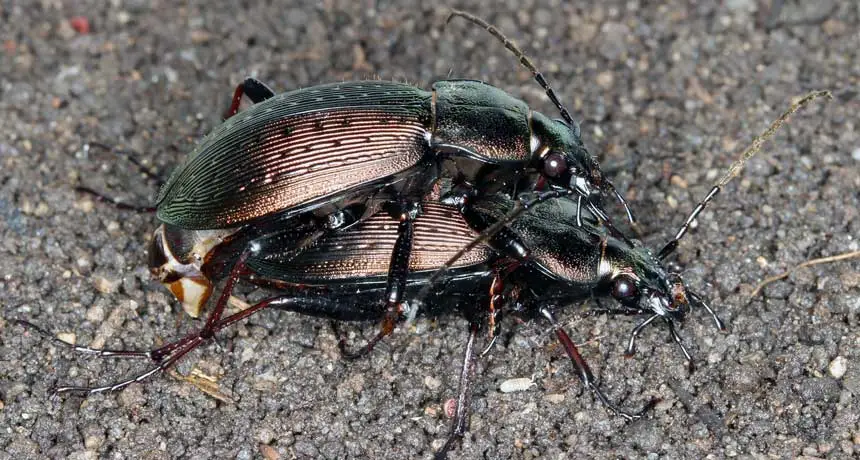
SEX AND WAR Among ground beetles (Carabus maiyasanus), the sizes of male and female genitals stay in sync despite genetic quirks that allow for more evolutionary freedom.
Teiji Sota/Kyoto Univ.
A new peek at the genetics of beetle genitals reveals the underpinnings of a battle of the sexes.
When mating, males of Japan’s flightless Carabus beetles insert a chitin-covered appendage that, once inside a female, pops out a plump sperm-delivery tube as well as a side projection called a copulatory piece. That piece doesn’t deliver any sperm, but steadies the alignment by fitting just so into a special pocket inside the female reproductive tract.
Researchers in Japan have now identified several regions of DNA that include genes controlling the length and width of the piece and pocket. Instead of being controlled mostly by the same genes, the beetles seem to have a fair amount of genetic freedom in changing one sex’s doodad dimensions without also resizing the other sex’s counterpart, evolutionary ecologist Teiji Sota of Kyoto University and colleagues say June 26 in Science Advances.
Within a given species of these beetles, males and females have evolved compatible sizes, but the capacity for mismatching shows up in hybrids. Out-of-sync sizes can cause ruptures, snap-offs and generally low numbers of offspring. This misfortune matters not just to a few unlucky beetles, but to the whole process of forming species, or speciation.
“I personally think that one of the greatest remaining mysteries in evolutionary biology is the role of genital evolution in speciation,” says Justa Heinen-Kay of the University of Minnesota in St. Paul. She was not part of the beetle work, but has studied fish genital evolution. Across the animal kingdom, shapes of genitals are among the most rapidly evolving traits, she points out. There are species that otherwise look almost exactly alike that specialists distinguish by differences in genitals.
One early idea linking genital shape with the formation of species proposed that developing a unique his-and-hers fit worked as a lock and key that separated members of one species from another. One of Sota’s early papers, in 1998, proposed that the genital quirks of the ground beetles worked as just this kind of separator of species.
The lock-and-key concept sounded great, says Brian Langerhans of North Carolina State University in Raleigh. But disputes over evidence of the process led “to many believing it played little role in reality.” Recently though, he says, the idea is rousing interest again.
Sota has started exploring the genetics governing size in the ground beetles’ proposed locks and keys. Earlier research had suggested a battle of the sexes over genital size. Longer could be better for a male, as it may help outcompete a less-endowed guy in the struggle to fertilize a female’s egg. Yet longer male parts can damage females, unless a female’s parts lengthen, too. Biologists have proposed that certain traits, for instance the sizes of his and her organs, stay in sync in a species because the same genes influence both the male and female form. Appealing as that idea might sound, in this case, the beetle researchers are now arguing against it.
The evidence comes from analyzing the odd genital forms in hybrids of two beetle species that manage to mate. The patterns of variety in the offsprings’ genital width and length suggest that genes for female pocket width are not tied to male piece width, and are only loosely related to male length. The females thus have some freedom genetically to vary on their own. What’s keeping male and female parts in sync for the beetles, Sota suggests, is not shared genes but shared consequences. Parents with the wrong-sized genitals just don’t have a lot of offspring.






